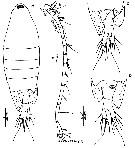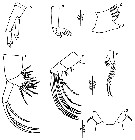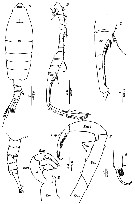|
|
 |
Fiche d'espèce de Copépode |
|
|
Calanoida ( Ordre ) |
|
|
|
Diaptomoidea ( Superfamille ) |
|
|
|
Tortanidae ( Famille ) |
|
|
|
Tortanus ( Genre ) |
|
|
|
Atortus ( Sous-Genre ) |
|
|
| |
Tortanus (Atortus) minicoyensis Francis & Bijoy Nandan, 2019 (F,M) | |
| | | | | | | Ref.: | | | Francis & Bijoy Nandan, 2019 (p.427, Descr. F, M, figs. F, M, molecular analysis, phylogeny, species key; comparison between species F, M of the subgenus in the Indian) |  Issued from : S.V. Francis & S. Bijoy Nandan in Turkish J. Zool., 2019, 43. [p.427, Fig.2]. Female (from Minicoy Island): A, habitus (dorsal); B, A1; C, urosome (dorsal: arrows indicate 2 ropunded processes on the caudal rami); D, u!rosome (ventral; the coupling device is dotted in A,C, D). Nota: - Prosome about 3.5 times as long as urosome. - Cephalosome and 1st pediger somite separated, 4th and 5th pedigers fused. - 5th pediger asymmetrical, left margin with a notch, right margin with a single downward directed triangular lobe. - Urosome 2-segmented. - Genital compound somite asymmetrical; right margin with a prominent bulge at about midpoint with 2 ventrolateral pointed spines. Genital operculum semicircular, ventrally located at anterior 1/3 of the genital compound. - 2nd urosomite (anal) completely fused with caudal rami. - Caudal rami asymmetrical, with 2 rounded processes. Left ramus slightly broader than right ramus. - All specimens carrying hyaline coupling device with left process larger than the right one, covering the dorsolateral process of 5th pedigerous somite and left lateral surface of genital compound . - A2 15-segmented, symmetrical, reaching posterior margin of caudal ramus.
|
 Issued from : S.V. Francis & S. Bijoy Nandan in Turkish J. Zool., 2019, 43. [p.428, Fig.3]. Female: A, A2; B, M^d palp; C, Md gnathobase; D, Mx1; E, Mx2; F, Mxp; G, P5. Nota: - A2 : coxa unarmed; basis and 1st endopodal segment fused with medial seta at proximal third, distomedial seta and distolateral row of spinules, 2nd and distal segments incompletely fused, distal segment with proximolateral setules and 6 apical setae. Exopod 3-segmented, proximal segment short, naked; middle and distal segment incompletely fused with 3 and 2 setae, respectively. - Md blade with 5 cuspidate teeth, main tooth and 2nd ventral-most tooth separated by wide diastema; both teeth with articulated tip; dorsal-most tooth monocuspidate while remaining 2 teeth bicuspidate, 4 dorsal-most teeth with 4 longitudinal spinule rows proximally. Md palp: basis elongate, cylindrical and unarmed; endopod 2-segmented, proximal unarmed, distal with 6 setae; exopod 1-segmented , with 5 setae. - Mx1: basis absent, precoxal arthrite with 11 spinulose setae apically and 2 setae dorsally; coxal endite with 3 stout, spiinulose terminal setae. - Mx2:syncoxal endites with 1, 2, 2, and 3 setae from proximal to distal; basal endite with 1 developed and 2 rudimentary setae; endopod with 5 stout setae with claw-like tip and 2 rudimentary setae. - Mxp: syncoxa with 2 endites, each with spinulose seta; basis unarmed; endopod with 3 medial spinulose setae and lateral seta.
|
 Issued from : S.V. Francis & S. Bijoy Nandan in Turkish J. Zool., 2019, 43. [p.429, Fig.4]. Female: A, P21; B, P2; C, P3; C, P3; D, P4. All legs (anterior view)
|
 Issued from : S.V. Francis & S. Bijoy Nandan in Turkish J. Zool., 2019, 43. [p.431, Table 1]. Female: Seta (in Arabic numerals) and spine (in Roman numerals) formula of P1 to P4.
|
 Issued from : S.V. Francis & S. Bijoy Nandan in Turkish J. Zool., 2019, 43. [p.430, Fig.5]. Male: A, habitus (dorsal); B, right A1; C, A1 ancestral segments XIX and XX; D, urosome (right lateral view); E, right P5 (posterior view); F, left P5 (posterior view); G, 2nd exopodal segment of left P5. Cox: coxa; Bas: basis; Exp: exopod; Exp 1: 1st exopodal segment; Exp 2: 2nd exopodal segment. Arrows indicate 3 rounded processes on the basis of left P5. Nota: - P5 asymmetrical; left leg longer than the right, coxa without seta; basis elongate, straight, with 3 low, rounded processes at regular intervals and lateral seta at distal third and madial seta halfway along the inner margin of the segment. Exopod 2-segme,ted, proximal segment with proximomedial , digitiform process bea(ring subdistal seta, distal segment with patches of setules on the anterior surface, 2 lateral minute setae, 2 medial setae, and blunt subdistal seta strongly curved along the hemispherical tip of the segment with the granular surface (fig.5G).
|
 Issued from : S.V. Francis & S. Bijoy Nandan in Turkish J. Zool., 2019, 43. [p.434, Table 4]. Differential diagnosis of T. minocoyensis female. Compare with other species of the subgenus Atortus species from the Indian Ocean. Morphological characters female: -
|
 ssued from : S.V. Francis & S. Bijoy Nandan in Turkish J. Zool., 2019, 43. [p.435, Table 5]. Differential diagnosis of T. minocoyensis male. Compare with other species of the subgenus Atortus species from the Indian Ocean.
|
 ssued from : S.V. Francis & S. Bijoy Nandan in Turkish J. Zool., 2019, 43. [p.432, Fig.6]. Molecular analysis: mitochondrial cytochrome oxydase subunit I sequences obtained with 642 base pairs confirms the female-male correspondence and shows the genetic identity of the species which is compared with mtCOI sequences of congeners. Maximum likelihood tree exhibited the differential assemblage of congeneric species of the genus Tortanus. Female and male T. minicoyensis sequences were arrayed within a single clade with a high bootstrap value (100%), which is distinct from all other sequences of subgenus Atortus based on 1000 bootstrap pseudo-replicas. The outgroup N. insignis exhibited maximum divergence array. The level of inter- and intraspecific divergence persisting within the genus Tortanus was evident from the distance matrix data. Specifically, T. minicoyensis possessed an intraspecificf sequence divergence ranging from 0%-0.4%
| | | | | NZ: | 1 | | |
|
Carte de distribution de Tortanus (Atortus) minicoyensis par zones géographiques
|
| | | | | | | Loc: | | | NW Indian (Minicoy Island)
Type locality: 8°05' N, 73°37' E. | | | | N: | 1 | | | | Lg.: | | | (1241) F: 2,66-2,94; M: 2,25-2,74; {F: 2,25-2,74; M: 2,25-2,74} | | | | Rem.: | For Francis & Bijoy Nandan (2019, p.431), from the structure of female P5, male A1 and P5, this new species is assigned to the tropicus species complx within the subgenus Atortus. The female of T. minicoyensis can be distinguished from all other species of the tropicus Group (T. bowmani; T. digitalis; T. giesbrechti; T. longipes; T. rubidus; T. ryukyuensis; T. taiwanicus; T. tropicus; T. vietnamicus; T. andamanensis; T. sigmoides by: 1- the asymmetrical 5th pedigerous somite with notched left margin and triangular lobe on the right; 2- hyaline coupling device with larger left process covering the dorsolateral process of 5th pediderous somite and left lateral surface of genital compound somite; 3- 2 ventrolateral spines in the genital compound somite; 4- asymmetrical caudal rami with 2 medial rounded processes in the female. The male is distinguished from all the other species of the tropical Group by: 1- serrated ridge of the right A1 produced proximally over 1/3 of segment XIX and the ridge slightly raised from the surface plane of the segment; 2- beak-shaped medial process on the right P5 coxa; 3- triangular medial process with a depression on the distomedial margin on the basis; 4- strongly curved subdistal seta on the left P5.
The authors find this species swarming . The swarming behavior members of the subgenus Atortus have been observed in oligotrophic clear waters mainly in subtropical and tropical areas. | | | Dernière mise à jour : 11/02/2020 | |
|
|
 Toute utilisation de ce site pour une publication sera mentionnée avec la référence suivante : Toute utilisation de ce site pour une publication sera mentionnée avec la référence suivante :
Razouls C., Desreumaux N., Kouwenberg J. et de Bovée F., 2005-2025. - Biodiversité des Copépodes planctoniques marins (morphologie, répartition géographique et données biologiques). Sorbonne Université, CNRS. Disponible sur http://copepodes.obs-banyuls.fr [Accédé le 05 janvier 2026] © copyright 2005-2025 Sorbonne Université, CNRS
|
|
 |
 |








